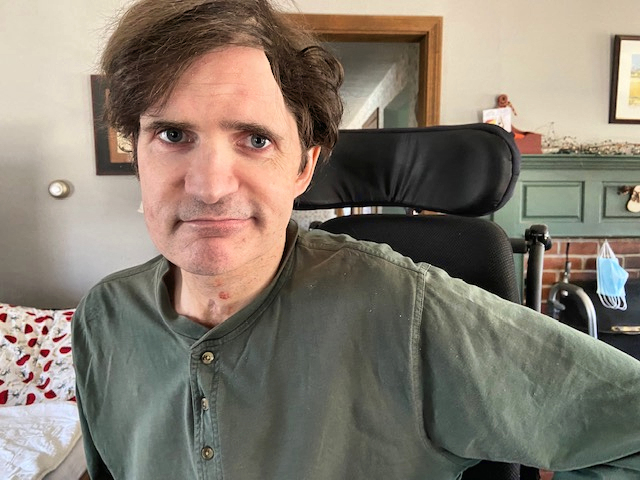May 2023 Tim Butterworth
April 25, 2023
 Tim Butterworth’s Journey
Tim Butterworth’s Journey
It was the phone call no parent ever wants to get.
In 2018, my husband Frank’s phone ID showed it was our 36-year-old son Tim, calling from California where he was a talented performing piano player at Disneyland. “Hi Tim!” he said, but it wasn’t Tim. It was an EMT calling on Tim’s phone from Oakland, CA, telling us Tim had had a seizure on a train platform, was unconscious, and was being rushed to a nearby trauma center.
Tim had been diagnosed with epilepsy when he was in college, and while he still had seizures, his condition was managed with medication. We flew to CA immediately to meet with neurologists and neurosurgeons who told us he was on life support in ICU and needed a craniectomy to relieve his life-threatening brain swelling. When we saw him many hours later, we wouldn’t have known him: with a caved in skull and misshapen face, it was the most traumatic experience we ever endured.
His 3 brothers and girlfriend flew in the next day, and as only one visitor was allowed in the Neurosciences ICU at a time, we took turns in the waiting room and sitting with him. He was unconscious, with a breathing machine, and more IV bags than we could count. We held his hand and talked to him all the time. His survival was in question for nearly a week, and when the doctors felt he was somewhat more stable, they told us if they could get him in a wheelchair and able to feed himself, that’s all we could hope for, then handed me a box of tissues.
Tim was in ICU for another two weeks, then transferred to a step-down room. Wearing a medically protective helmet, he was transferred by ambulance to a specialized rehab center in Kentfield, CA. At this point he had aphasia, apraxia, right side paralysis, and he was unable to swallow and had a G tube inserted into his stomach for nutrition. He had no ability to communicate, receptive or expressive.
Following therapy there, he was transferred back to the John Muir Trauma Center Acute Rehab floor where therapies continued, and eventually his skull piece was surgically reinserted. Progress was slow, and we were in California for four months. Frank retired to be Tim’s caretaker, and I took a leave from my teaching job. Tim’s brothers and girlfriend flew out frequently to support us.
Those were long, emotional days, but Tim was finally discharged to return to New England. The massive expenses, planning, insurance, medical care, therapies, and transportation were staggering, and we often didn’t know which way to turn. We eventually made all the contacts and referrals and flew to Boston. Tim was under the care of a team of exceptional specialists at Mass General. Our oldest son, Andy, and family live near Boston, and they transformed a few rooms in their house so Frank and Tim could live there while continuing medical and therapy services in Boston. I returned to Maine to teach four days a week, started seeing a gifted and compassionate therapist, and returned to Boston for three days a week.
Tim was making good progress with therapies, could walk a little on his own, and could feed himself, but the seizures continued. As they can be life-threatening, his neurosurgeon and epileptologist recommended seizure monitoring tests done at MGH, where brain activity could be measured and hopefully pinpoint the source of the seizures.
Unfortunately, one of the robotically placed sensors caused a brain bleed, and he was comatose in ICU and on life support for weeks. He had a trach put in. His survival was in question every single day, with frequent complications, infections…it was finally determined that he needed to have shunts placed in his brain to drain excess cerebral spinal fluid. Several more brain surgeries followed, including the removal of a walnut-size piece of his brain that was identified as the source of seizures. We spent weeks holding his hands and talking to our comatose son, most of the time in tears ourselves. We took turns sleeping at the hospital and going back to Andy’s house.
I can’t even put into words how devastating, wrenching, heartbreaking all of this was. His neurosurgeon once said, “This is a life changing experience.” At the time we had no idea how profound that statement was. Life changing, indeed. An understatement for sure.
Months later, brain fluids were balanced, and he was transferred to a Spaulding rehab in Cambridge that was equipped to handle medical issues as well as some therapies. We were so anxious to get him to the Flagship Spaulding in Charlestown for the best therapies in the world, and he eventually made it there. For ten months, he went back and forth from Spaulding to Mass General to address unanticipated problems.
At this point, he could say a few words (“Hi Mom” was what I most wanted to hear), was wheelchair bound, dependent on the g-tube because of the risk of aspiration pneumonia, incontinent, totally dependent on nurses and us for every aspect of his life.
Finally in May 2020, he returned to Maine. We had our house retrofitted, our amazing case manager at Spaulding, Janet Keith, arranged every contact and service we could ever need, including putting us in touch with Sarah Gaffney and Katy Bizier at BIAA-ME, and arranged for a hospital bed, supplies, and handicapped van. I left my teaching job.
Tim received home services (OT, PT, SPL) for two years, (in those years, he was also hospitalized at MMC for aspiration pneumonia, a hip fracture, kidney issues, and had to go back to Mass General for several more brain surgeries), then transferred his therapies to out-patient at NE Rehab Hospital in Portland, where he continues to work with the most dedicated professionals imaginable.
He can finally eat his favorite foods, can speak some words and phrases, and walk short distances with a rolling walker, but he is still dependent. He’s come a long way from the initial prognosis of just sitting in a wheelchair and feeding himself.
Our biggest challenges? Daily care, helping him accept what he’s lost, especially his phenomenal career as a performing musician and independent life. We were told today that his decreasing right-side functionality is likely a result of the TBI. We need to expand his world somehow.
We don’t know what Tim’s potential is. Nobody does. We are grateful that we can care for him, challenging as that is, because after all, he’s our son.
Debbie Butterworth, Tim’s mom

